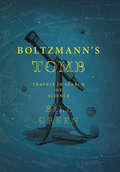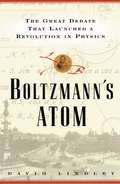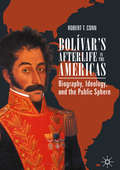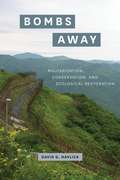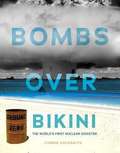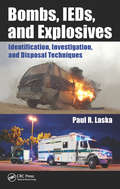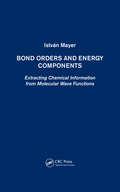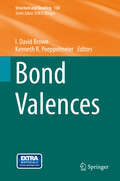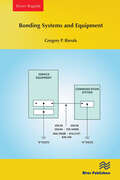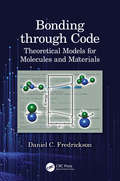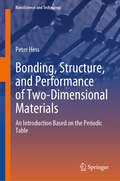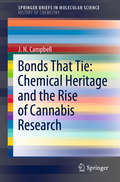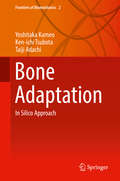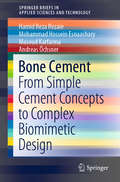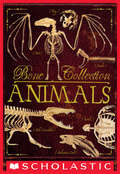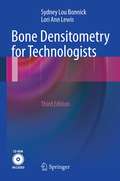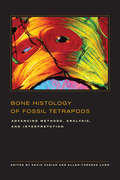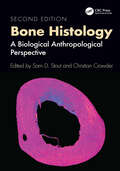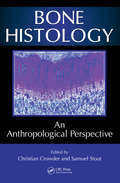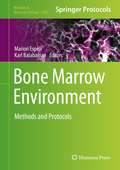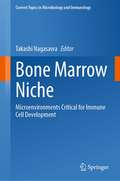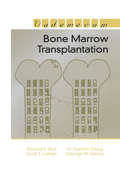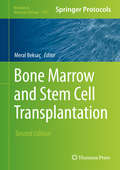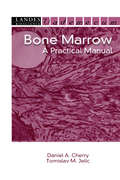- Table View
- List View
Boltzmann's Tomb
by Bill GreenA selection of the Scientific American book clubRecommended by MSNBC, Los Angeles Times, & American Association for the Advancement of Science's SB&F magazine"This wonderful scientific memoir captures the romance and beauty of research in precise poetic prose that is as gorgeous and evocative as anything written by Rilke, painted by Seurat, or played by Casals." -Mary Doria Russell, author of Doc and The Sparrow"A radiant love letter to science from a scientist with a poet's soul . . . Green is an exquisite writer, and his fierce focus and mastery of style are reminiscent of the biologist and essayist Lewis Thomas." -Kirkus ReviewsIn Boltzmann's Tomb, Bill Green interweaves the story of his own lifelong evolution as a scientist, and his work in the Antarctic, with a travelogue that is a personal and universal history of science. Like Richard Holmes' The Age of Wonder-this book serves as a marvelous introduction to the great figures of science. Along with lyrical meditations on the tragic life of Galileo, the wildly eccentric Tycho Brahe, and the visionary Sir Isaac Newton, Green's ruminations return throughout to the lesser-known figure of Ludwig Boltzmann. Using Boltzmann's theories of randomness and entropy as a larger metaphor for the unpredictable paths that our lives take, Green shows us that science, like art, is a lived adventure. Bill Green is a geochemist and professor emeritus at Miami University in Oxford, Ohio. He is also the author of Water, Ice & Stone: Science and Memory on the Antarctic Lakes which received the American Museum of Natural History's John Burroughs Award for Nature Writing, was a finalist for the PEN/Martha Albrand Award, and was excerpted in The Ends of the Earth: An Anthology of the Finest Writing on the Arctic and the Antarctic, edited by Elizabeth Kolbert.
Boltzmanns Atom: The Great Debate That Launched A Revolution In Physics
by David LindleyIn 1900 many eminent scientists did not believe atoms existed, yet within just a few years the atomic century launched into history with an astonishing string of breakthroughs in physics that began with Albert Einstein and continues to this day. Before this explosive growth into the modern age took place, an all-but-forgotten genius strove for forty years to win acceptance for the atomic theory of matter and an altogether new way of doing physics. Ludwig Boltz-mann battled with philosophers, the scientific establishment, and his own potent demons. His victory led the way to the greatest scientific achievements of the twentieth century. Now acclaimed science writer David Lindley portrays the dramatic story of Boltzmann and his embrace of the atom, while providing a window on the civilized world that gave birth to our scientific era. Boltzmann emerges as an endearingly quixotic character, passionately inspired by Beethoven, who muddled through the practical matters of life in a European gilded age. Boltzmann's story reaches from fin de siècle Vienna, across Germany and Britain, to America. As the Habsburg Empire was crumbling, Germany's intellectual might was growing; Edinburgh in Scotland was one of the most intellectually fertile places on earth; and, in America, brilliant independent minds were beginning to draw on the best ideas of the bureaucratized old world. Boltzmann's nemesis in the field of theoretical physics at home in Austria was Ernst Mach, noted today in the term Mach I, the speed of sound. Mach believed physics should address only that which could be directly observed. How could we know that frisky atoms jiggling about corresponded to heat if we couldn't see them? Why should we bother with theories that only told us what would probably happen, rather than making an absolute prediction? Mach and Boltzmann both believed in the power of science, but their approaches to physics could not have been more opposed. Boltzmann sought to explain the real world, and cast aside any philosophical criteria. Mach, along with many nineteenth-century scientists, wanted to construct an empirical edifice of absolute truths that obeyed strict philosophical rules. Boltzmann did not get on well with authority in any form, and he did his best work at arm's length from it. When at the end of his career he engaged with the philosophical authorities in the Viennese academy, the results were personally disastrous and tragic. Yet Boltzmann's enduring legacy lives on in the new physics and technology of our wired world. Lindley's elegant telling of this tale combines the detailed breadth of the best history, the beauty of theoretical physics, and the psychological insight belonging to the finest of novels.
Bolívar’s Afterlife in the Americas: Biography, Ideology, and the Public Sphere
by Robert T. ConnSimón Bolívar is the preeminent symbol of Latin America and the subject of seemingly endless posthumous attention. Interpreted and reinterpreted in biographies, histories, political writings, speeches, and works of art and fiction, he has been a vehicle for public discourse for the past two centuries. Robert T. Conn follows the afterlives of Bolívar across the Americas, tracing his presence in a range of competing but interlocking national stories. How have historians, writers, statesmen, filmmakers, and institutions reworked his life and writings to make cultural and political claims? How has his legacy been interpreted in the countries whose territories he liberated, as well as in those where his importance is symbolic, such as the United States? In answering these questions, Conn illuminates the history of nation building and hemispheric globalism in the Americas.
Bombs Away: Militarization, Conservation, and Ecological Restoration
by David G. HavlickWhen viewed from space, the Korean Peninsula is crossed by a thin green ribbon. On the ground, its mix of dense vegetation and cleared borderlands serves as home to dozens of species that are extinct or endangered elsewhere on the peninsula. This is Korea’s demilitarized zone—one of the most dangerous places on earth for humans, and paradoxically one of the safest for wildlife. Although this zone was not intentionally created for conservation, across the globe hundreds of millions of acres of former military zones and bases are being converted to restoration areas, refuges, and conservation lands. David G. Havlick has traveled the world visiting these spaces of military-to-wildlife transition, and in Bombs Away he explores both the challenges—physical, historical, and cultural—and fascinating ecological possibilities of military site conversions. Looking at particular international sites of transition—from Indiana’s Big Oaks National Wildlife Refuge to Cold War remnants along the former Iron Curtain—Havlick argues that these new frontiers of conservation must accomplish seemingly antithetical aims: rebuilding and protecting ecosystems, or restoring life, while also commemorating the historical and cultural legacies of warfare and militarization. Developing these ideas further, he shows that despite the ecological devastation often wrought by military testing and training, these activities need not be inconsistent with environmental goals, and in some cases can even complement them—a concept he calls ecological militarization. A profound, clear explication of landscapes both fraught and fecund, marked by death but also reservoirs of life, Bombs Away shows us how “military activities, conservation goals, and ecological restoration efforts are made to work together to create new kinds of places and new conceptions of place.”
Bombs Over Bikini: The World's First Nuclear Disaster
by Connie GoldsmithIn 1946, as part of the Cold War arms race, the US military launched a program to test nuclear bombs in the Marshall Islands of the Pacific Ocean. From 1946 until 1958, the military detonated sixty-seven nuclear bombs over the region's Bikini and Enewetak Atolls. The twelfth bomb, called Bravo, became the world's first nuclear disaster. It sent a toxic cloud of radiation over Rongelap Atoll and other nearby inhabited islands. The testing was intended to advance scientific knowledge about nuclear bombs and radiation, but it had much more far-reaching effects. Some of the islanders suffered burns, cancers, birth defects, and other medical tragedies as a result of radiation poisoning. Many of the Marshallese were resettled on other Pacific islands or in the United States. They and their descendants cannot yet return to Bikini, which remains contaminated by radiation. And while the United States claims it is now safe to resettle Rongelap, only a few construction workers live there on a temporary basis. For Bombs over Bikini, author Connie Goldsmith researched government documents, military film footage, and other primary source documents to tell the story of the world's first nuclear disaster. You'll meet the people who planned the test operations, the Marshall Islanders who lost their homes and suffered from radiation illnesses, and those who have worked to hold the US government accountable for catastrophically poor planning. Was the new knowledge about nuclear bombs and radiation worth the cost in human suffering? You decide.
Bombs, IEDs, and Explosives: Identification, Investigation, and Disposal Techniques
by Paul R. LaskaA guide on procedures, administration, and equipment, Bombs, IEDs, and Explosives: Identification, Investigation, and Disposal Techniques introduces concepts, basic knowledge, and necessary skill sets for bomb technicians. It covers topics such as training resources, bomb threat and incident response, legal aspects of bomb disposal, explosives and
Bonanza Girl
by Patricia BeattyA widow and her two children head for gold rush territory in Idaho, hoping to find jobs and a new life.
Bond Orders and Energy Components: Extracting Chemical Information from Molecular Wave Functions
by István MayerWhile modern computational methods can provide us with the wave function of a molecule in numerical form, most computer programs lack the sophisticated tools needed to extract chemical concepts from these wave functions. Saving researchers vast time and potential confusion, this volume collects and organizes those validated tools currently scattered throughout the literature and details their application. It provides immediate access for those needing to calculate such critical factors as bond order and valence indices, and atomic and diatomic contributions to molecular energy. Supporting material is available for download from the authors' continually updated website.
Bond Valences: The Bond Valence Model (Structure and Bonding #158)
by I. David Brown Kenneth R. PoeppelmeierThe series Structure and Bonding publishes critical reviews on topics of research concerned with chemical structure and bonding. The scope of the series spans the entire Periodic Table and addresses structure and bonding issues associated with all of the elements. It also focuses attention on new and developing areas of modern structural and theoretical chemistry such as nanostructures, molecular electronics, designed molecular solids, surfaces, metal clusters and supramolecular structures. Physical and spectroscopic techniques used to determine, examine and model structures fall within the purview of Structure and Bonding to the extent that the focus is on the scientific results obtained and not on specialist information concerning the techniques themselves. Issues associated with the development of bonding models and generalizations that illuminate the reactivity pathways and rates of chemical processes are also relevant. The individual volumes in the series are thematic. The goal of each volume is to give the reader, whether at a university or in industry, a comprehensive overview of an area where new insights are emerging that are of interest to a larger scientific audience. Thus each review within the volume critically surveys one aspect of that topic and places it within the context of the volume as a whole. The most significant developments of the last 5 to 10 years should be presented using selected examples to illustrate the principles discussed. A description of the physical basis of the experimental techniques that have been used to provide the primary data may also be appropriate, if it has not been covered in detail elsewhere. The coverage need not be exhaustive in data, but should rather be conceptual, concentrating on the new principles being developed that will allow the reader, who is not a specialist in the area covered, to understand the data presented. Discussion of possible future research directions in the area is welcomed. Review articles for the individual volumes are invited by the volume editors.
Bonding Systems and Equipment
by Gregory P. BieralsThe proper bonding of systems and equipment is critical for the protection of people and equipment. This is especially important in patient-care areas of health care facilities, installations serving information technology equipment, installation of wiring associated with swimming pools, installations of wiring and special equipment in hazardous (classified) locations, installations of medium and high voltage systems where step, touch, and transferred potential differences are a constant threat, and agricultural buildings.A complete analysis of the appropriate terms associated with proper bonding and grounding methods, as well as two examples of fault current calculations will further enhance the understanding of these important topics.The second chapter includes a 30 question quiz and an answer key.
Bonding through Code: Theoretical Models for Molecules and Materials
by Daniel C. FredricksonThis timely and unique publication is designed for graduate students and researchers in inorganic and materials chemistry and covers bonding models and applications of symmetry concepts to chemical systems. The book discusses the quantum mechanical basis for molecular orbital concepts, the connections between molecular orbitals and localized views of bonding, group theory, bonding models for a variety of compounds, and the extension of these ideas to solid state materials in band theory. Unlike other books, the concepts are made tangible to the readers by guiding them through their implementation in MATLAB functions. No background in MATLAB or computer programming is needed; the book will provide the necessary skills. Key Features Visualization of the Postulates of Quantum Mechanics to build conceptual understanding MATLAB functions for rendering molecular geometries and orbitals Do-it-yourself approach to building a molecular orbital and band theory program Introduction to Group Theory harnessing the 3D graphing capabilities of MATLAB Online access to a growing collection of applications of the core material and other appendices Bonding through Code is ideal for first-year graduate students and advanced undergraduates in chemistry, materials science, and physics. Researchers wishing to gain new tools for theoretical analysis or deepen their understanding of bonding phenomena can also benefit from this text. About the Author Daniel Fredrickson is a Professor in the Department of Chemistry at the University of Wisconsin–Madison, where his research group focuses on understanding and harnessing the structural chemistry of intermetallic phases using a combination of theory and experiment. His interests in crystals, structure, and bonding can be traced to his undergraduate research at the University of Washington (B.S. in Biochemistry, 2000) with Prof. Bart Kahr, his Ph.D. studies at Cornell University (2000–2005) with Profs. Stephen Lee and Roald Hoffmann, and his post-doctoral work with Prof. Sven Lidin at Stockholm University (2005–2008). As part of his teaching at UW–Madison since 2009, he has worked to enhance his department’s graduate course, Physical Inorganic Chemistry I: Symmetry and Bonding, through the incorporation of new material and the development of computer-based exercises.
Bonding, Structure, and Performance of Two-Dimensional Materials: An Introduction Based on the Periodic Table (NanoScience and Technology)
by Peter HessThis book presents a wealth of results obtained by first-principles calculations, molecular dynamics simulations, and tight-binding modeling on two-dimensional covalent bonding and the resulting formation of 2D materials. It focuses on the bonding–structure relationships derived from the periodicity of the electron configuration and atomic size, paying particular attention to the overall stability of various elemental and composite networks. In addition to accurate first-principles calculations, the book uses a linear combination of atomic orbitals and the hybridization concept to gain deep insight into the rules governing the world of 2D chemistry. Of special interest are the novel properties of 2D materials based on quantum confinement effects in two dimensions and the large surface-to-volume ratio. The book gives an introduction to the fundamental principles of 2D structure formation for newcomers in this field, simultaneously providing a comprehensive source of data on bonding strength, geometrical structure, and nanomechanics characterizing the manifold of chemical networks in two-dimensional space. This book is a valuable reference for material scientists, chemists, and any researcher in the field of 2D materials and low-dimensional nanoscience.
Bonds That Tie: Chemical Heritage and the Rise of Cannabis Research (SpringerBriefs in Molecular Science)
by J. N. CampbellThis book traces the global chemical history of cannabidiol (CBD), which is a compound that originates partially from hemp (the fiber), marijuana (the popularized term for medicinal/recreational use), and cannabis (the species sativa). It also argues about the position that CBD is in today and the heritage established by chemists over the course of its development. Each term associated with the plant spans centuries of development and cross-culturally became an object of cultivation and commerce. Humans have explored cannabis’ complex chemical possibilities with the hope that it would offer pain relief or some type of mind-numbing portal to other existences. As such the trio and their many incarnations have been and will continue to be an integral part of the past, the present, and the future. Known as cannabis compound cannabidiol (CBD), a non-psychoactive component of the drug, it is one of some 100-plus known cannabinoids; offshoots of the original plant that are isolated and, in some cases, chemically altered. Just as with any supposed pharmaceutical marvel, chemists are at the center of this narrative. In order to understand its historical roots, central to CBD’s discovery was the efforts of scientists who worked in separate eras and regions. These included, Americans Roger Adams and Allyn Howlett, and the Bulgarian-born Israeli chemist Raphael Mechoulam, along with a throng of others. They influenced a generation of students and changed the face of cannabis research into the 21st century. What does its history tell us about the future of chemical products like CBD? This brief will explore the chemical heritage that formed across a complicated nexus of global events. These are the bonds that tie.
Bone Adaptation: In Silico Approach (Frontiers of Biomechanics #2)
by Taiji Adachi Yoshitaka Kameo Ken-Ichi TsubotaThis book focuses on the systems biomechanics of bone remodeling that provide a multiscale platform for bone adaptation, spanning the cellular, tissue, and organ levels. The mathematical model explained in each section provides concrete examples of in silico approaches for bone adaptation. It will be immensely useful for readers interested in bone morphology and metabolism and will serve as an effective bridge connecting mechanics, cellular and molecular biology, and medical sciences. These in silico approaches towards exploring the mechanisms by which the functioning of dynamic living systems is established and maintained have potential for facilitating the efforts of graduate students and young researchers pioneering new frontiers of biomechanics.
Bone Cement: From Simple Cement Concepts to Complex Biomimetic Design (SpringerBriefs in Applied Sciences and Technology)
by Andreas Öchsner Hamid Reza Rezaie Mohammad Hossein Esnaashary Masoud KarfarmaThis book provides an overview of the composition of polymeric and ceramic bone cements. It also discusses complex, biomimetic structures based on biomaterials, such as cells and bioactive molecules, which more closely resemble natural bone The first chapter describes the main concepts of the cementation process and the parameters affecting it, while the second chapter focuses on the composition and structure of candidate biomaterials. Lastly, the third and fourth chapters present recent research aimed at improving the ability of naked biomaterials to enhance bone healing by adding cells and bioactive agents.
Bone Collection: Animals (Bone)
by Rob Scott Colson Rob ColsonSee what lies beneath an animal's skin!BONE COLLECTION: ANIMALS will feature a wide selection of animal skeletons and informative facts so kids can learn about the anatomy of their favorite animals. Featuring full-color photos and illustrations throughout, it will be just creepy enough to appeal to kids without being scary. From tiny animals like bats to large animals like lions, kids will discover what lies beneath their favorite animal's skin.
Bone Densitometry for Technologists
by Lori Ann Lewis Sydney Lou BonnickAs a technology, bone densitometry is really quite extraordinary. The ability to quantify the density of the bones at a variety of skeletal sites has truly revolutionized the approach to a number of diseases, the most important of which is osteoporosis. Using the information from the machines, especially dual-energy X ray absortiometry (DXA) technology, physicians can recommend and prescribe interventions that will slow bone loss and reduce the risk of disabling fractures. The remarkable advances in skeletal imaging with densitometry devices have made possible quantitative and diagnostic assessments of skeletal structure. However it is in fact the skill and concern of the technologist that enables all of this to happen. In this updated and expanded third edition of their gold standard and highly praised Bone Densitometry for Technologists, Sydney Lou Bonnick, MD, FACP, and Lori Ann Lewis, MRT, CDT, again offer the most comprehensive review of the standards and developments in the field. Here radiologic technologists, nurse practitioners, physician assistants, and dedicated densitometry technologists can find not only the state-of-the-art guidelines for bone density testing, but also a wide range of other topics, including several new chapters. These include a new chapter on the performance of DXA lumbar spine, proximal femur and forearm studies; one on Using Absolute Risk to Predict Fracture Risk in Clinical Practice; and another providing examples of highly instructional DXA images in which artifacts or structural changes can be seen. There are 2 new appendices and the other 10 appendices from the previous edition have been updated wherever necessary to reflect the most current information available. In Appendix XII, the contents of the accompanying CD-ROM are reviewed. On this CD, readers will find the Precision Calculator Companion that was first included with the 2nd edition of Dr. Bonnick’s title, Bone Densitometry in Clinical Practice. Questionnaires designed to capture essential information to utilize FRAX for both men and women are also included on the CD. These questionnaires can be persomalized to better suit a practice's needs. Finally, a continuing education review is also found on the CD, which, if successfully completed, will result in the awarding of 16 hours of Category A credit acceptable to the American Society of Radiologic Technologists.
Bone Histology of Fossil Tetrapods
by Kevin Padian Ellen-Thérèse LammThe microscopic examination of fossilized bone tissue is a sophisticated and increasingly important analytical tool for understanding the life history of ancient organisms. This book provides an essential primer and manual for using fossil bone histology to investigate the biology of extinct tetrapods. Twelve experts summarize advances in the field over the past three decades, reviewing fundamental basics of bone microanatomy and physiology. Research specimen selection, thin-section preparation, and data analysis are addressed in detail. The authors also outline methods and issues in bone growth rate calculation and chronological age determination, as well as how to examine broader questions of behavior, ecology, and evolution by studying the microstructure of bone.
Bone Histology: A Biological Anthropological Perspective
by Christian Crowder Sam D. StoutBone Histology: A Biological Anthropological Perspective, Second Edition builds on the success of the first edition, recognizing the significant advances that have occurred in bone biology, histology, and histological techniques and methods in subsequent years. Bones and teeth are of considerable importance for anthropological and related research, due to their nature as hard tissues. The physical remains of humans available to biological anthropologists, bioarchaeologists, paleopathologists, and paleontologists are, with exception to forensic anthropology, limited to skeletal material; fortunately, the same characteristics of hard tissues that lead to their persistence after death make them a storehouse of information about biological processes experienced during the life of the individual. This book covers important aspects of bone biology which underlie the microstructure of hard tissues that are crucial for histological analysis. This includes an overview of two major metabolic processes, bone remodelling and modelling, and their importance for understanding and interpreting bone histomorphology. Subsequent chapters apply histological methods to the biological profile, such as estimation of age and evaluation of pathological conditions that affect the skeleton, or to determine whether remains are human or nonhuman. Finally, there is a discussion of current research trends in bone histology, with a focus on technological advances in imaging and methods. Reviews of four well-documented skeletal collections—developed specifically for bone histological and imaging research—are discussed, as well as, the importance of such collections for future research. Bone Histology, Second Edition has assembled a collection of contributing authors, with extensive experience and expertise in various aspects of hard tissue biology, to provide readers with an overview of the current state of research and potential applications of histological analysis in biological anthropology, forensic anthropology, and skeletal biology. It serves as a valuable resource for students, researchers, and practitioners in these and related disciplines.
Bone Histology: An Anthropological Perspective
by Christian Crowder Sam StoutA broad understanding of bone and tooth microstructure is necessary for constructing the biological profile of an individual or individuals within a population. Bone Histology: An Anthropological Perspective brings together authors with extensive experience and expertise in various aspects of hard tissue histology to provide a comprehensive discuss
Bone Marrow Environment: Methods and Protocols (Methods in Molecular Biology #2308)
by Marion Espéli Karl BalabanianThis volume brings together classical and cutting-edge protocols on the spatio-temporal study of the cellular subsets constituting the bone and the marrow in both mouse and human. Chapters details methods on bone marrow (BM) ecosystem, to label, sort, analyse, and culture specific cell subsets as well as techniques allowing the evaluation of the function of some of the cellular elements of the BM. Written in the highly successful Methods in Molecular Biology series format, chapters include introductions to their respective topics, lists of the necessary materials and reagents, step-by-step, readily reproducible laboratory protocols, and tips on troubleshooting and avoiding known pitfalls. Authoritative and cutting-edge, Bone Marrow Environment: Methods and Protocols aims to help new investigators to pursue the characterization of the BM microenvironment in the coming years.
Bone Marrow Niche: Microenvironments Critical for Immune Cell Development (Current Topics in Microbiology and Immunology #434)
by Takashi NagasawaThis volume summarizes recent advances in research on mesenchymal cell populations in the bone marrow. It explores how mesenchymal cells create niches for immune cells in extramedullary organs and it discusses new concepts of lympho-hematopoietic microenvironments. Readers are introduced to the fundamentals of hematopoietic stem cells (HSCs) differentiation to all types of blood cells, including immune cells, in the bone marrow. The book highlights how this process is supported and regulated by the individual microenvironments of stem cells, termed niches.The identity of HSC niches has been subject to longstanding debates. Recent studies identified the population of mesenchymal stem cells as the major cellular component of niches, for hematopoietic stem and progenitor cells (HSPCs) and their candidate developmental origin. Furthermore, candidate cellular niches for immune cells in lymph nodes and adipose and connective tissues were identified. The authors of this volume focus on shared features between those and HSPC niche cells in the bone marrow. Covering latest research results, this book serves as fascinating read for researchers and clinicians in hematology and immunology.
Bone Marrow Transplantation
by Richard K. Burt H. Joachim Deeg Scott Thomas Lothian George W. SantosThis handbook is a therapeutic manual designed as a quick, practical guide and reference for house officers, fellows, pharmacists and nurses on the bone marrow transplant unit. Indications, complications, drug doses and approaches to clinical management problems are emphasized. Diseases requiring bone marrow transplants are reviewed along with pati
Bone Marrow and Stem Cell Transplantation (Methods in Molecular Biology #1109)
by Meral BeksaçThis volume is a compendium of cutting-edge molecular methods for the successful transplantation of hematopoietic stem cells. The contributors are world-renown leaders in the field. They describe promising tools for stem cell transplant research models, such as in vivo bioluminescence imaging. They discuss HLA typing, PCR-SSP typing, and HLA antigens. This volume is an invaluable source for biochemists, molecular biologists, and clinicians.
Bone Marrow: A Practical Manual
by Daniel A. Cherry Tomislav M. JelicThe intentions of this manual are to familiarize beginners with the process of bone marrow evaluation, to provide a succinct preparatory review of bone marrow pathology for the pathology and clinical hematology board examinations, to remediate practitioners whose knowledge of this field is not current, and to strengthen the skills of clinicians who
